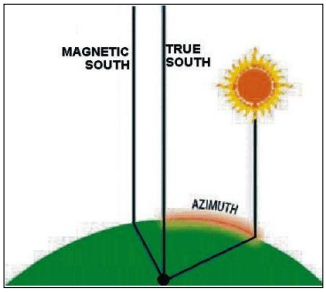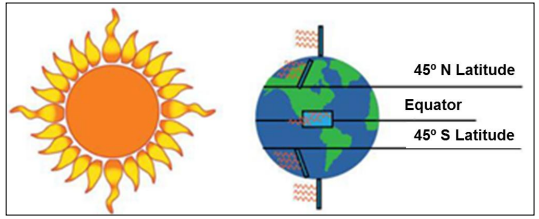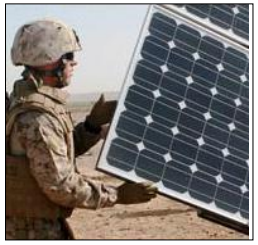Photovoltaic (PV) Systems
PV systems are designed to harvest energy directly from sunlight. They include solar panels, batteries, power control electronics and accessories that enable power applications.
Solar Insolation Considerations
Solar insolation is the amount of solar radiation energy received on a given surface area during a given period of time. It is used as a measure of how much of the sun’s energy is striking a location on the earth’s surface over a given time and, hence, is available for harvesting. It is typically denoted as Watts per hours per square meter. On a clear day with the sun rays directly perpendicular to a surface, the total instantaneous power density (solar irradiance) of the sun’s rays is about 1,000 watts per square meter.
PV modules harvest solar rays and produce direct current (DC). These modules are most productive when the panels face directly into the sun (i.e. are as close to perpendicular to the sun’s rays as practical). Two factors affect the angle at which the sun’s rays strike a solar panel:
- Direction / azimuth
- Tilt angle
Diffuse and Direct Solar Radiation
As sunlight passes through the atmosphere, some of it is absorbed, scattered, and reflected by:
- Air molecules
- Water vapor
- Clouds
- Dust
- Pollutants
- Forest fires
- Volcanoes
This is called diffuse solar radiation.
The solar radiation that reaches the Earth’s surface without being diffused is called direct beam solar radiation. The sum of the diffuse and direct solar radiation is called global solar radiation. Atmospheric conditions can reduce direct beam radiation by 10% on clear, dry days and by 100% during thick, cloudy days.
Azimuth is the horizontal direction expressed as the angular distance between the direction of a fixed point and the direction of the object. In PV terms, it is the sun’s apparent location east and west of true south (northern hemisphere) or true north (southern hemisphere). See Figure 1. To optimize power output in most areas, align the fixed panels to face true south (not magnetic south) in the northern hemisphere and true north in the southern hemisphere.

Depending on the location, it can be beneficial to compensate for environmental effects. For example; if the location is in a valley with mountains to the west, it may be more beneficial to face the solar generator with solar panels a little to the east and collect extra power during the morning. This will compensate for losing power in the afternoon from the shade caused by the mountains.
NOTE: If the environmental effects and proper azimuth are uncertain, the system should remain facing true south (in the northern hemisphere) or true north (in the southern hemisphere).
Tilt angle refers to the PV panel’s vertical angle relative to the ground. Optimum tilt angle is a function of the sun’s elevation relative to the horizon at the location of interest on the earth at any given time. Once a panel aligned to the proper azimuth, the tilt angle is determined. The two factors that determine the optimum tilt angle are: Latitude and Time of year. For a fixed solar panel system, a general year round rule is to set tilt angle equal to the latitude. For example; at the north and south poles, the latitude will equal 90°. At 45° North or South latitude the tilt angle of the solar panels should be 45°, and at the equator the solar panels should be laid flat. Figure 4 summarizes this. If the solar panels have an adjustable tilt angle, adjust as follows: ·
- Winter – latitude plus fifteen degrees
- Summer – latitude minus fifteen degrees

Solar Panels, Modules and Arrays
Solar modules are made up of a number of solar cells linked in a solar panel through series and parallel circuits. Figure 5 shows a solar panel. Most solar modules produce a relatively low amount of voltage and amperage. Depending on load requirements, multiple modules can be used together, creating a solar array, to reach the desired energy production. This allows tailored solar production which can match the type of load requirements that exist.

Solar Energy Storage
Batteries store electrical energy. Within solar systems, batteries store harvested energy for use as needed to include providing power during limited light and no-light conditions. It is important to know what types of batteries are in use. Improper use can severely damage batteries, reducing overall lifespan and power output. Like PV cells, batteries can be connected in series to increase voltage, or in parallel to increase current.
WARNING: Solar systems are silent energy systems. Always assume live voltage is present.
